Feasibility of Waste Engine Oil Electrooxidation with Ni-Co and Cu-B Catalysts
Abstract
1. Introduction
2. Materials and Methods
3. Results
3.1. Electrooxidation of Waste Engine Oil Emulsion on the Ni-Co Catalyst
3.2. Electrooxidation of Waste Oil Emulsion on the Cu-B Catalyst
4. Discussion
5. Conclusions
Author Contributions
Funding
Institutional Review Board Statement
Informed Consent Statement
Conflicts of Interest
References
- Centralna Ewidencja Pojazdów i Kierowców CEPiK. Data from 2022 Pursuant to art. 80a Paragraph. 1 and 100a sec. 1 of the Act of June 20, 1997—Road Traffic Law (Poland). Available online: http://www.cepik.gov.pl/statystyki (accessed on 13 October 2022).
- Automarket.pl (the Owner of the Automarket.pl Website is PKO Bank Polski). Available online: https://automarket.pl/blog/rynek/jak-pandemia-koronawirusa-zmienila-rynek-sprzedazy-samochodow/ (accessed on 28 July 2020).
- Communication From the Commission to the European Parliament, The Council, The European Economic and Social Committee and the Committee of the Regions Empty, ‘Fit for 55′: Delivering the EU’s 2030 Climate Target on the way to climate neutrality, European Commission, Brussels, 14 July 2021. Available online: https://eur-lex.europa.eu/legal-content/EN/TXT/?uri=CELEX%3A52021DC0550 (accessed on 2 February 2022).
- Hopmans, J.J. The Problem of the Processing of Spent Oil in the Member States of EEC; Report for the European Economic Community (EEC); National Institute for Wastewater Treatment: Dordrecht, The Netherlands, 1974. [Google Scholar]
- Kajdas, C. Major pathways for used oil disposal and recycling, Part 1. Tribotest J. 2000, 7, 61–74. [Google Scholar] [CrossRef]
- Fuentes, M.J.; Font, R.; Gómez-Rico, M.F.; Martín-Gullón, I. Pyrolysis and combustion of waste lubricant oil from diesel cars: Decomposition and pollutants. J. Anal. Appl. Pyrol. 2007, 79, 215–226. [Google Scholar] [CrossRef]
- Naima, K.; Liazid, A. Waste oils as alternative fuel for diesel engine: A review. J. Pet. Technol. Altern. Fuels 2013, 4, 30–43. [Google Scholar] [CrossRef]
- Hamawand, I.; Yusaf, T.; Rafat, S. Recycling of waste engine oils using a new washing agent. Energies 2013, 6, 1023–1049. [Google Scholar] [CrossRef]
- Whisman, M.L.; Reynolds, J.W.; Goetzinger, J.W.; Cotton, F.O.; Brinkman, D.W. Re-refining makes quality oils. Hydrocarb. Process. 1978, 57, 141–145. [Google Scholar]
- Nerin, C.; Domeno, C.; Moliner, R.; Lazaro, M.J.; Suelves, I.; Valderrama, J. Behavior of different industrial waste oils in a pyrolysis process: Metals distribution and valuable products. J. Anal. Appl. Pyrol. 2000, 55, 171–183. [Google Scholar] [CrossRef]
- Chen, G.; He, G. Separation of water and oil from water-in-oil emulsion by freeze/thaw method. Sep. Purif. Technol. 2003, 31, 83–89. [Google Scholar] [CrossRef]
- Kwon, W.-T.; Park, K.; Han, S.D.; Yoon, S.M.; Kim, J.Y.; Bae, W.; Rhee, Y.W. Investigation of water separation from water-in-oil emulsion using electric field. J. Ind. Eng. Chem. 2010, 16, 684–687. [Google Scholar] [CrossRef]
- Von Fuchs, G.H.; Diamond, H. Oxidation characteristics of lubricating oils. Ind. Eng. Chem. 1942, 34, 927–937. [Google Scholar] [CrossRef]
- Rahimi, B.; Semnani, A.; Nezamzadeh-Ejhieh, A.; Shakoori Langeroodi, H.; Davood, M.H. Monitoring of the physical and chemical properties of a gasoline engine oil during its usage. J. Anal. Methods Chem. 2012, 2012, 819524. [Google Scholar] [CrossRef]
- Bhaskar, T.; Uddin, M.A.; Muto, A.; Sakata, Y.; Omura, Y.; Kimura, K.; Kawakami, Y. Recycling of waste lubricant oil into chemical feedstock or fuel oil over supported iron oxide catalysts. Fuel 2004, 83, 9–15. [Google Scholar] [CrossRef]
- Demirbas, A.; Demirbas, I. Importance of rural bioenergy for developing countries. Energy Convers. Manag. 2007, 48, 2386–2398. [Google Scholar] [CrossRef]
- Boughton, B.; Horvath, A. Environmental assessment of waste oil management methods. Env. Sci. Technol. 2004, 38, 353–358. [Google Scholar] [CrossRef] [PubMed]
- El-Fadel, M.; Khoury, R. Strategies for vehicle waste-oil management: A case study. Resour. Conserv. Recycl. 2001, 33, 75–91. [Google Scholar] [CrossRef]
- Rincón, J.; Cañizares, P.; García, M.T. Waste oil recycling using mixtures of polar solvents. Ind. Eng. Chem. Res. 2005, 44, 7854–7859. [Google Scholar] [CrossRef]
- Arpa, O.; Yumrutas, R.; Demirbas, A. Production of diesel-like fuel from waste engine oil by pyrolitic distillation. Appl. Energy 2010, 87, 122–127. [Google Scholar] [CrossRef]
- Maceiras, R.; Alfonsín, V.; Morales, F.J. Recycling of waste engine oil for diesel production. Waste Manag. 2017, 60, 351–356. [Google Scholar] [CrossRef]
- Littlepage, M. Waste Oil Recycling Apparatus. U.S. Patent 5,188,156, 23 February 1993. [Google Scholar]
- Betts, H.S. Diesel Engine Waste oil Recycling System. U.S. Patent 5,476,073, 19 December 1995. [Google Scholar]
- Beck, B.D.; Brain, J.D.; Wolfthal, S.F. Assessment of lung injury produced by particulate emissions of space heaters burning automotive waste oil. In Inhaled Particles VI, Proceedings of an International Symposium and Workshop on Lung Dosimetry Organised by the British Occupational Hygiene Society in Co-Operation with the Commission of the European Communities, Cambridge; Elsevier: Amsterdam, The Netherlands, 1988; pp. 257–265. [Google Scholar]
- Delistraty, D.; Stone, A. Dioxins, metals, and fish toxicity in ash residue from space heaters burning used motor oil. Chemosphere 2007, 68, 907–914. [Google Scholar] [CrossRef]
- Redey, L. Ogniwa Paliwowe; Wydawnictwa Naukowo-Techniczne: Warszawa, Poland, 1973. [Google Scholar]
- Hoogers, G. Fuel Cell Technology Handbook; CRC Press: Boca Raton, FA, USA, 2003. [Google Scholar]
- Larminie, J.; Dicks, A. Fuel Cell System Explained, 2nd ed.; John Wiley & Sons: Hoboken, NJ, USA, 2003. [Google Scholar]
- O’Hayre, R.; Cha, S.W.; Colella, W.; Prinz, F.B. Fuel Cell Fundamentals; John Wiley & Sons: Hoboken, NJ, USA, 2005. [Google Scholar]
- Stolten, D. Hydrogen and Fuel Cells. Fundamentals, Technologies and Applications; Wiley-VCH: Weinheim, Germany, 2010. [Google Scholar]
- Mekhilef, S.; Saidur, R.; Safari, A. Comparative study of different fuel cell technologies. Renew. Sustain. Energy Rev. 2012, 16, 981–989. [Google Scholar] [CrossRef]
- Włodarczyk, P.P.; Włodarczyk, B. Applicability of Waste Engine Oil for the Direct Production of Electricity. Energies 2021, 14, 1100. [Google Scholar] [CrossRef]
- Asazawa, K.; Yamada, K.; Tanaka, H.; Oka, A.; Taniguchi, M.; Kobayashi, T. A platinum-free zero-carbon-emission easy fuelling direct hydrazine fuel cell for vehicles. Angew. Chem. 2007, 119, 8170–8173. [Google Scholar] [CrossRef]
- Rolison, D.R.; Hagans, P.L.; Swider, K.E.; Long, J.W. Role of hydrous ruthenium oxide in Pt-Ru direct methanol fuel cell anode catalysis: The importance of mixed electron/proton conductivity. Langmuir 1999, 15, 774–779. [Google Scholar] [CrossRef]
- Steigerwalt, E.S.; Deluga, G.A.; Cliffel, D.E.; Lukehart, C.M.A. Pt-Ru/graphitic carbon nanofiber nanocomposite exhibiting high relative performance as a direct-methanol fuel cell anode catalyst. J. Phys. Chem. B 2001, 105, 8097–8101. [Google Scholar] [CrossRef]
- Serov, A.; Robson, M.H.; Halevi, B.; Artyushkova, K.; Atanassov, P. Highly active and durable templated non-PGM cathode catalysts derived from iron and aminoantipyrine. Electrochem. Commun. 2012, 22, 53–56. [Google Scholar] [CrossRef]
- Armour, M.A. Hazarodous Laboratory Chemicals Disposal Guide; CRC Press: Boca Raton, FL, USA, 2003. [Google Scholar]
- Gasteiger, H.A.; Koch, S.S.; Sompalli, B.; Wagner, F.T. Activity benchmarks and requirements for Pt, Pt-alloy, and non-Pt oxygen reduction catalysts for PEMFCs. Appl. Catal. B Environ. 2005, 56, 9–35. [Google Scholar] [CrossRef]
- Poynton, S.D.; Kizewski, J.P.; Slade, R.C.T.; Varcoe, J.R. Novel electrolyte membranes and non-Pt catalysts for low temperature fuel cells. Solid State Ion. 2010, 181, 219–222. [Google Scholar] [CrossRef]
- Othman, R.; Dicks, A.L.; Zhu, Z. Non precious metal catalysts for the PEM fuel cell cathode. Int. J. Hydrogen Energy 2012, 37, 357–372. [Google Scholar] [CrossRef]
- Williams, H.; Gnanamani, M.K.; Jacobs, G.; Shafer, W.D.; Coulliette, D. Fischer–Tropsch Synthesis: Computational Sensitivity Modeling for Series of Cobalt Catalysts. Catalysts 2019, 9, 857. [Google Scholar] [CrossRef]
- Jo, S.B.; Kim, T.Y.; Lee, C.H.; Woo, J.H.; Chae, H.J.; Kang, S.-H.; Kim, J.W.; Lee, S.C.; Kim, J.C. Selective CO Hydrogenation Over Bimetallic Co-Fe Catalysts for the Production of Light Paraffin Hydrocarbons (C2–C4): Effect of Space Velocity, Reaction Pressure and Temperature. Catalysts 2019, 9, 779. [Google Scholar] [CrossRef]
- Włodarczyk, P.P.; Włodarczyk, B. Microbial Fuel Cell with Ni–Co Cathode Powered with Yeast Wastewater. Energies 2018, 11, 3194. [Google Scholar] [CrossRef]
- Włodarczyk, B.; Włodarczyk, P.P. The Membrane-Less Microbial Fuel Cell (ML-MFC) with Ni-Co and Cu-B Cathode Powered by the Process Wastewater from Yeast Production. Energies 2020, 13, 3976. [Google Scholar] [CrossRef]
- Qasim, M.; Bashir, M.S.; Iqbal, S.; Mahmood, Q. Recent advancements in α-diimine-nickel and -palladium catalysts for ethylene polymerization. Eur. Polym. J. 2021, 160, 110783. [Google Scholar] [CrossRef]
- Abas, M.; Bahadur, A.; Ashraf, Z.; Iqbal, S.; Muhammad Shahid Riaz Rajoka, M.S.R.; Rashid, S.G.; Jabeen, E.; Iqbal, Z.; Abbas, Q.; Bais, A.; et al. Designing novel anticancer sulfonamide based 2,5-disubstituted-1,3,4-thiadiazole derivatives as potential carbonic anhydrase inhibitor. J. Mol. Struct. 2021, 1246, 131145. [Google Scholar] [CrossRef]
- Zhang, R.; Gao, R.; Gou, Q.; Lai, J.; Li, X. Recent Advances in the Copolymerization of Ethylene with Polar Comonomers by Nickel Catalysts. Polymers 2022, 14, 3809. [Google Scholar] [CrossRef]
- Paraska, O.; Karvan, S. Mathematical modelling in scientific research of chemical technology processes. Tech. Trans. Mech. Crac. Univ. Technol. Press 2010, 8, 203–210. [Google Scholar]
- Survila, A.; Mockus, Z.; Kanapeckaitė, S.; Samulevičienė, M. Effect of syntanol DS-10 and halides on tin(II) reduction kinetics. Electrochim. Acta 2005, 50, 2879–2885. [Google Scholar] [CrossRef]
- Ignatov, O.V.; Shalunova, I.V.; Panchenko, L.V.; Turkovskaia, O.V.; Ptichkina, N.M. Degradation of Syntanol DS-10 by bacteria immobilized in polysaccharide gels (article in Russian). Prikl. Biokhimiia Mikrobiol. 1995, 31, 220–223. [Google Scholar]
- Kravchenko, A.V.; Rudnitskii, A.G.; Nesterenko, A.F.; Kublanovskii, V.S. Degradation of Syntanol DS-10 promoted by energy transfer reactions. Ukr. Chem. J. 1994, 60, 11–13. [Google Scholar]
- Włodarczyk, P.P.; Włodarczyk, B. Wastewater Treatment and Electricity Production in a Microbial Fuel Cell with Cu–B Alloy as the Cathode Catalyst. Catalysts 2019, 9, 572. [Google Scholar] [CrossRef]
- Włodarczyk, P.P.; Włodarczyk, B. Ni-Co alloy as catalyst for fuel electrode of hydrazine fuel cell. China-USA Bus. Rev. 2015, 14, 269–279. [Google Scholar] [CrossRef]
- Włodarczyk, P.P.; Włodarczyk, B. Preparation and Analysis of Ni–Co Catalyst Use for Electricity Production and COD Reduction in Microbial Fuel Cells. Catalysts 2019, 9, 1042. [Google Scholar] [CrossRef]
- Włodarczyk, B.; Włodarczyk, P.P. Comparison of Cu-B Alloy and Stainless Steel as Electrode Material for Microbial Fuel Cell. In Renewable Energy Sources: Engineering, Technology, Innovation; Wróbel, M., Jewiarz, M., Szlęk, A., Eds.; Springer Proceedings in Energy; Springer: Cham, Switzerland, 2020. [Google Scholar] [CrossRef]
- Włodarczyk, B.; Włodarczyk, P.P. Electrooxidation of methyl alcohol with Ni-Co catalyst. In Infrastructure and Ecology of Rural Areas; Polish Academy of Sciences: Kraków, Poland, 2018; Volume 2, pp. 305–315. [Google Scholar] [CrossRef]
- Włodarczyk, B.; Włodarczyk, P.P. Microbial fuel cell with Cu-B cathode powering with wastewater from yeast production. J. Ecol. Eng. 2017, 18, 224–230. [Google Scholar] [CrossRef]
- Holtzer, M.; Staronka, A. Chemia Fizyczna. Wprowadzenie; Wydawnictwo AGH: Kraków, Poland, 2000. [Google Scholar]
- Bielański, A. Podstawy Chemii Nieorganicznej; Wydawnictwo Naukowe PWN: Warsaw, Poland, 2013. [Google Scholar]
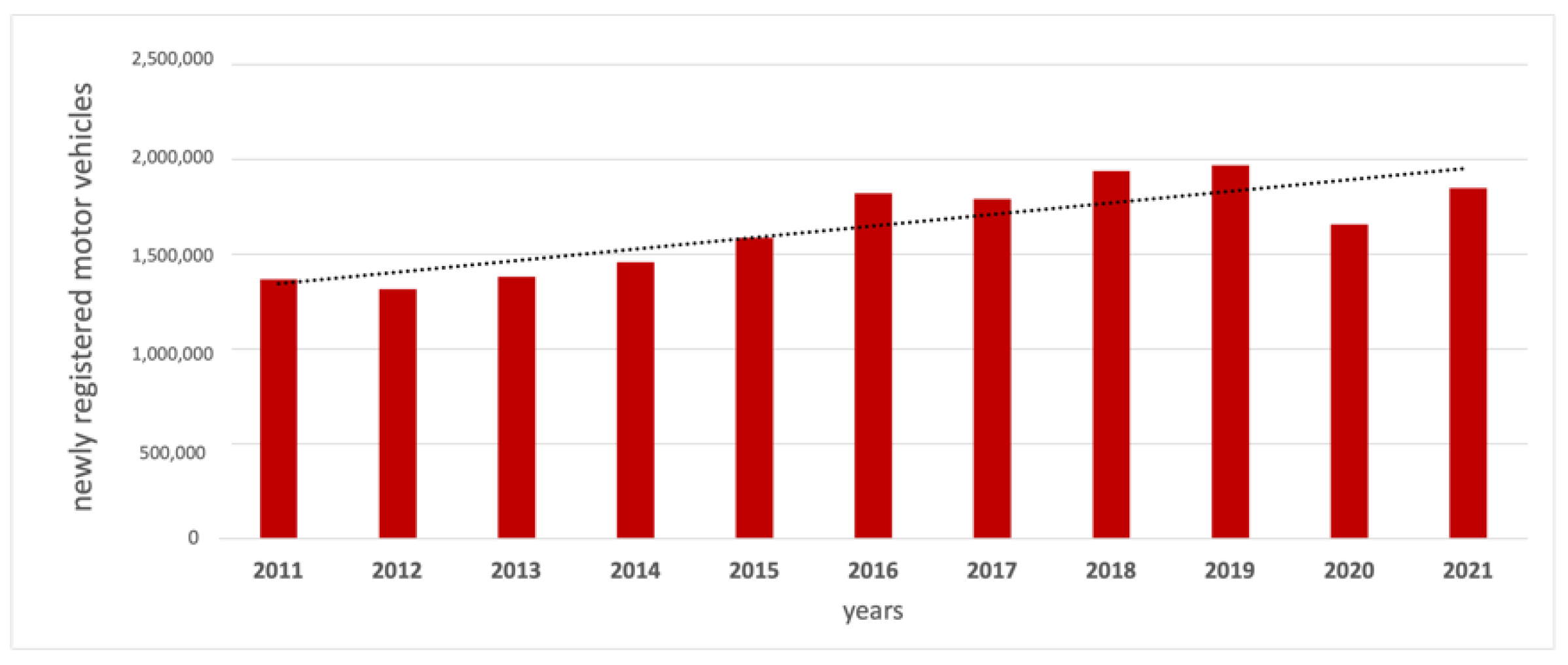
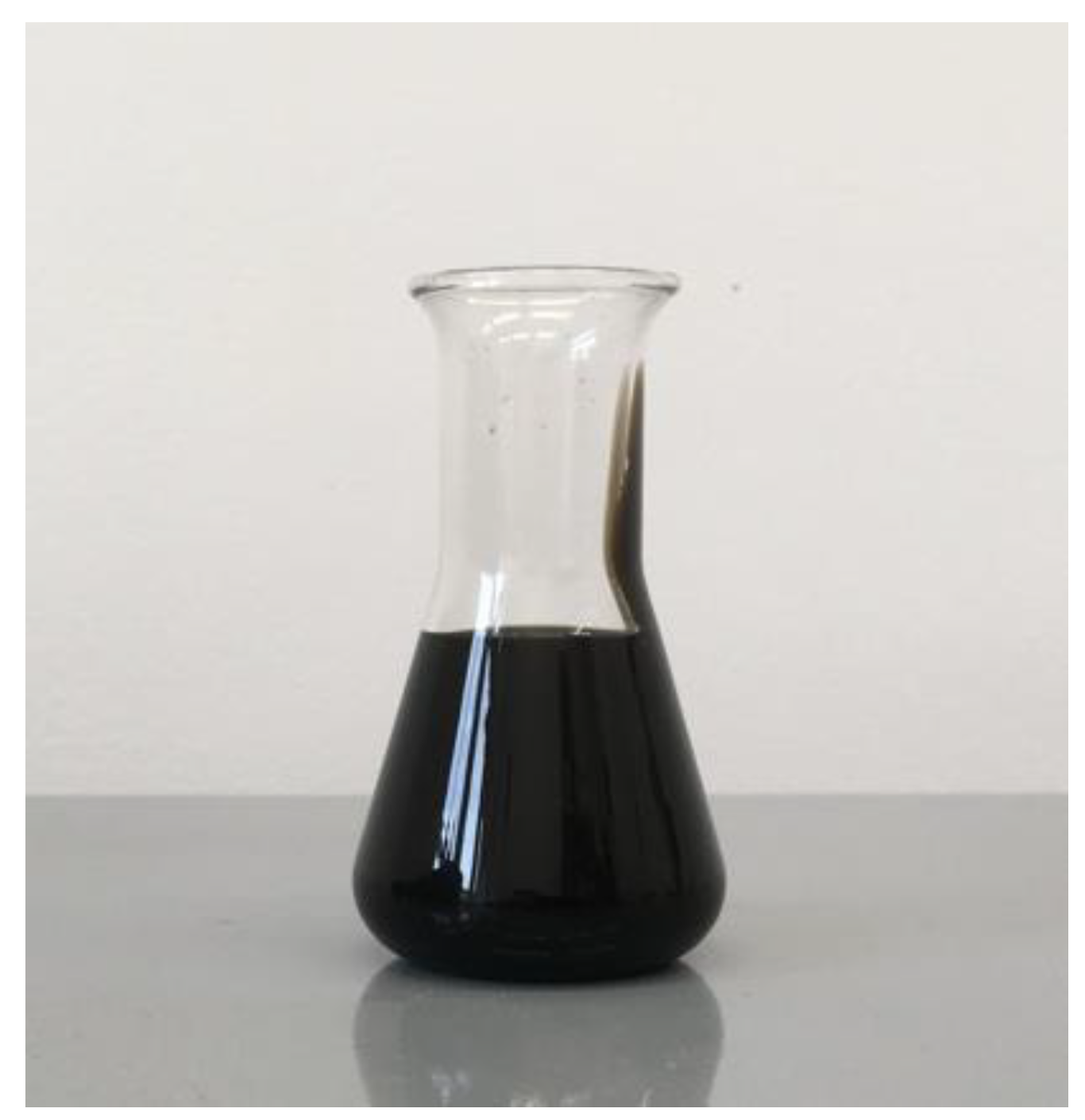
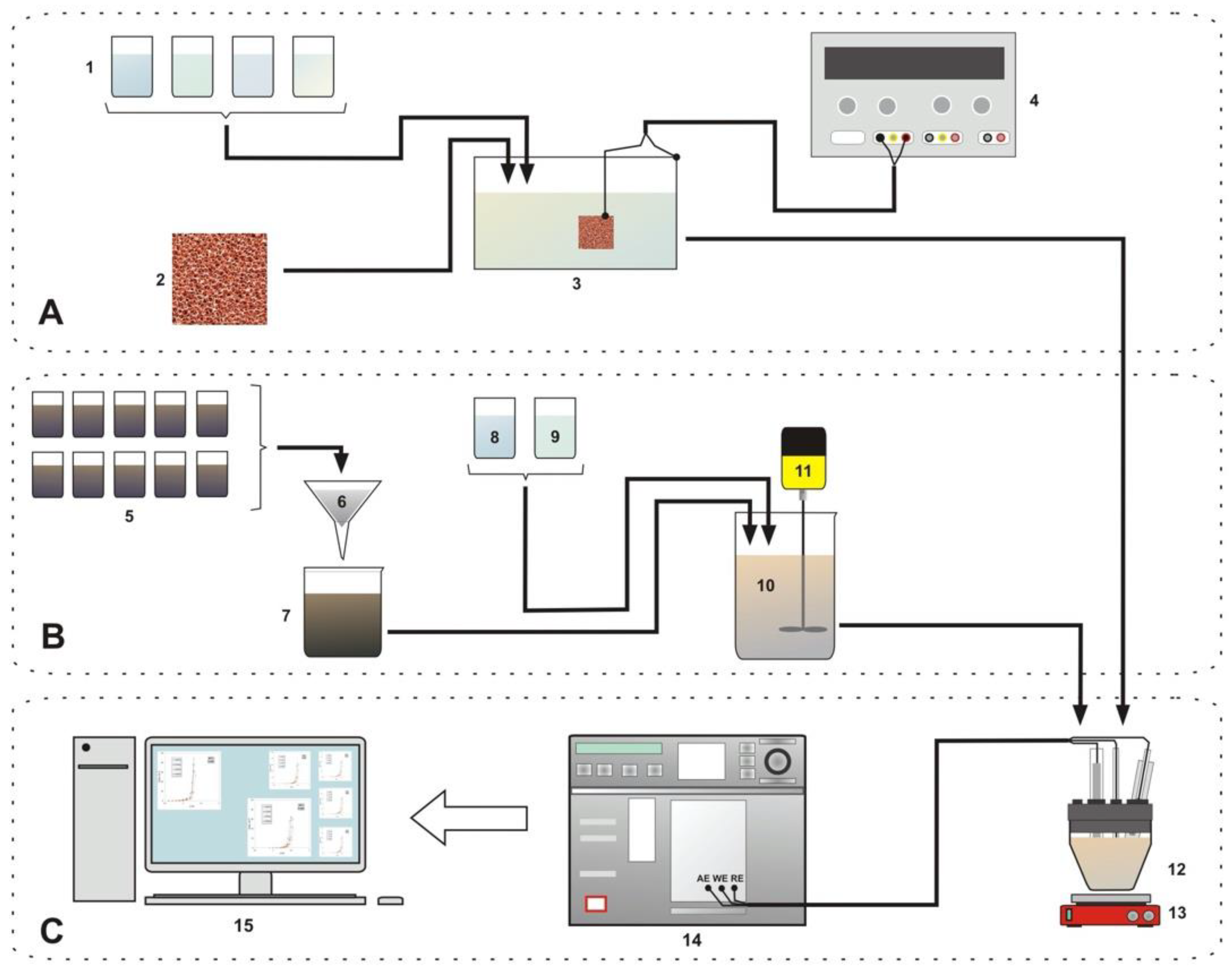

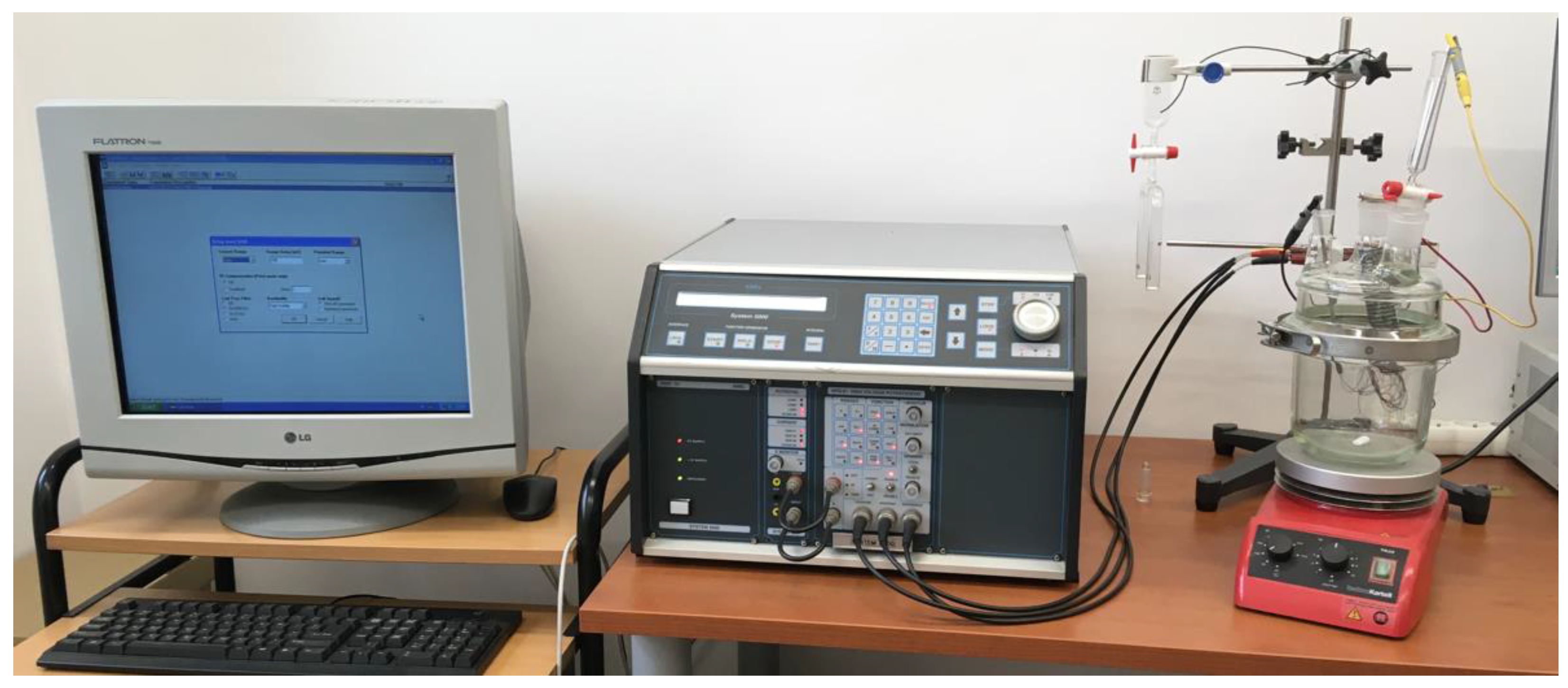

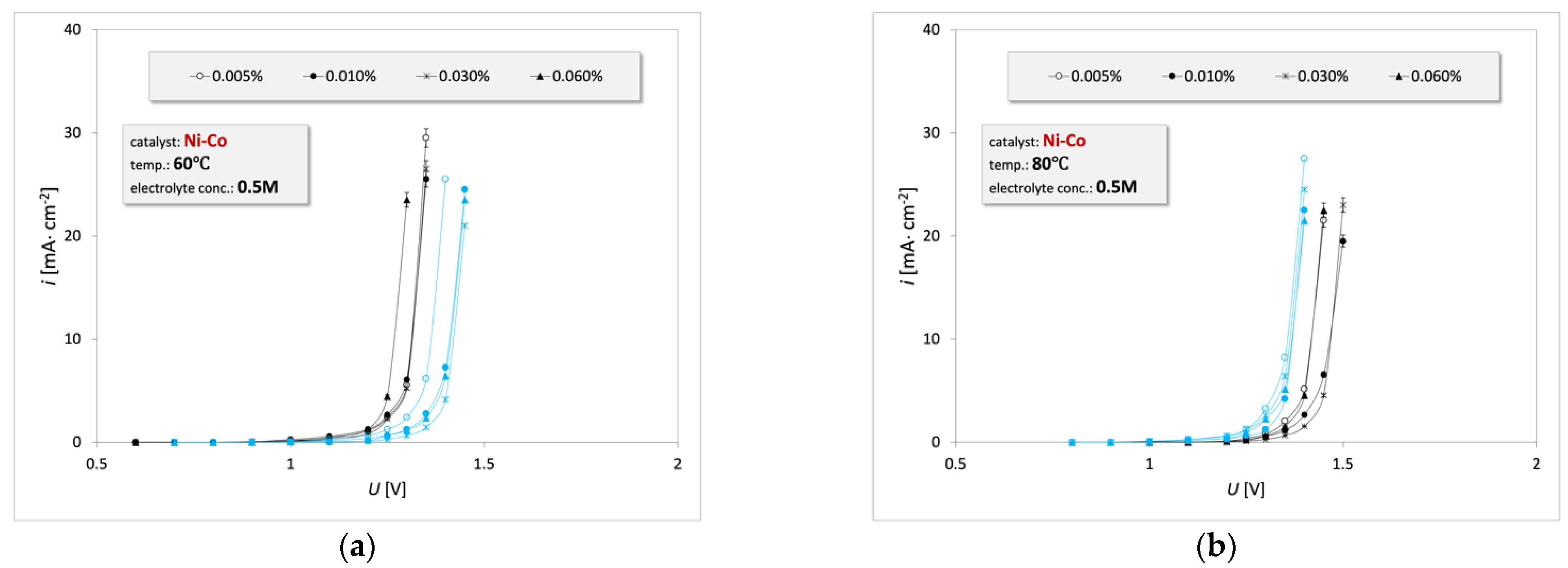
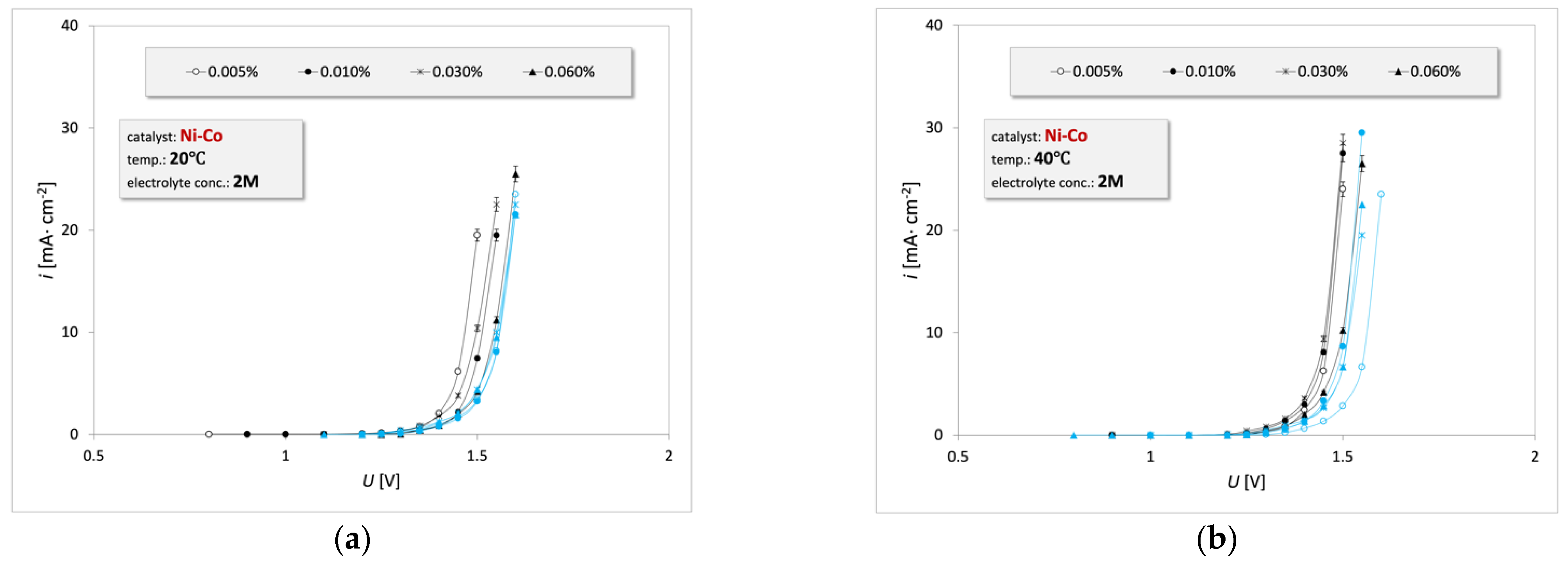
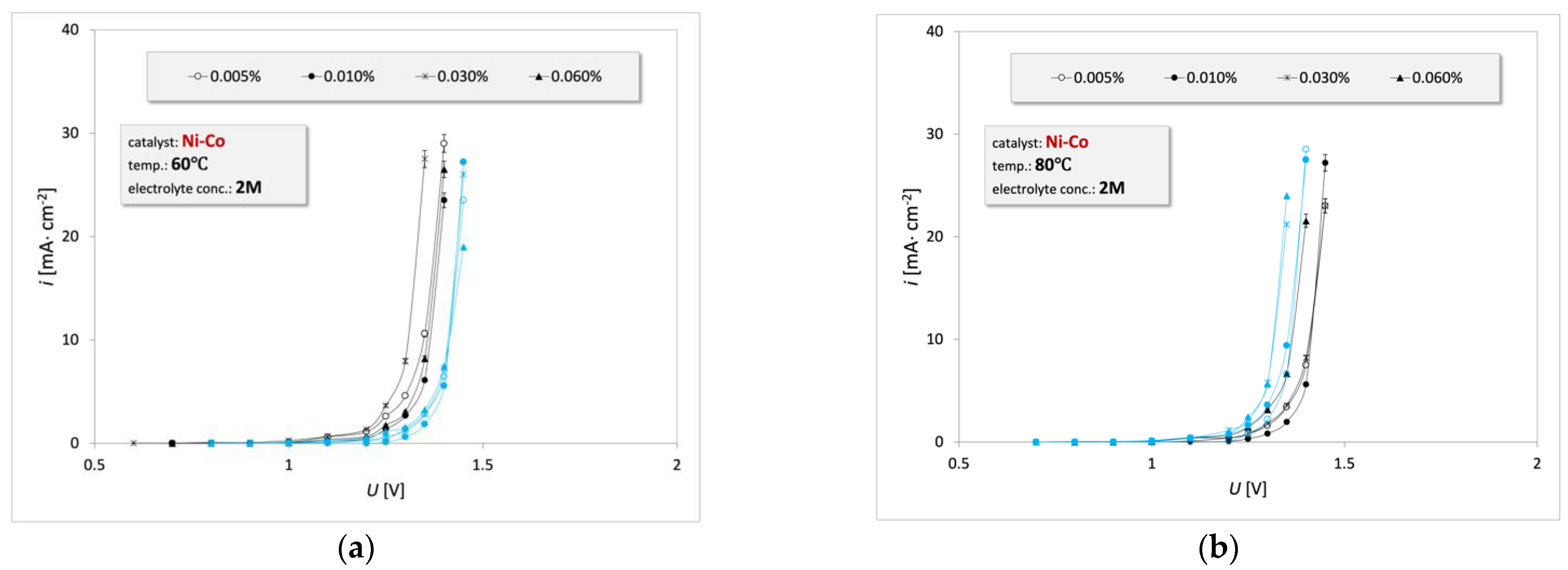




| Engine Oil Grade 1 | Type of Engine 1 | Capacity and Power 1 | Oil Mileage 1 |
|---|---|---|---|
| 5W30 | Diesel 2 | 1.5; 115 hp 4 | 30,000 km |
| 5W30 | Diesel 2 | 1.5; 115 hp 4 | 15,000 km |
| 5W30 | Diesel 2 | 1.6; 92 hp 4 | 15,000 km |
| 5W30 | Diesel 2 | 3.0; 245 hp 4 | 15,000 km |
| 5W40 | Petrol 3 | 1.0i; 68 hp 4 | 15,000 km |
| 10W40 | Petrol 3 | 3.0i; 180 hp 4 | 15,000 km |
| 15W40 | Petrol 3 | 2.0; 105 hp 4 | 10,000 km |
| 10W40 | Petrol 3 | 1.0i; 72 hp 4 | 15,000 km |
| 10W40 | LPG 3 | 2.0i; 115 hp 4 | 15,000 km |
| 10W40 | LPG 3 | 1.4i; 75 hp 4 | 10,000 km |
Publisher’s Note: MDPI stays neutral with regard to jurisdictional claims in published maps and institutional affiliations. |
© 2022 by the authors. Licensee MDPI, Basel, Switzerland. This article is an open access article distributed under the terms and conditions of the Creative Commons Attribution (CC BY) license (https://creativecommons.org/licenses/by/4.0/).
Share and Cite
Włodarczyk, P.P.; Włodarczyk, B. Feasibility of Waste Engine Oil Electrooxidation with Ni-Co and Cu-B Catalysts. Energies 2022, 15, 7686. https://doi.org/10.3390/en15207686
Włodarczyk PP, Włodarczyk B. Feasibility of Waste Engine Oil Electrooxidation with Ni-Co and Cu-B Catalysts. Energies. 2022; 15(20):7686. https://doi.org/10.3390/en15207686
Chicago/Turabian StyleWłodarczyk, Paweł P., and Barbara Włodarczyk. 2022. "Feasibility of Waste Engine Oil Electrooxidation with Ni-Co and Cu-B Catalysts" Energies 15, no. 20: 7686. https://doi.org/10.3390/en15207686
APA StyleWłodarczyk, P. P., & Włodarczyk, B. (2022). Feasibility of Waste Engine Oil Electrooxidation with Ni-Co and Cu-B Catalysts. Energies, 15(20), 7686. https://doi.org/10.3390/en15207686







